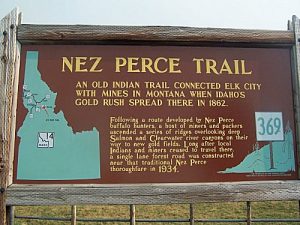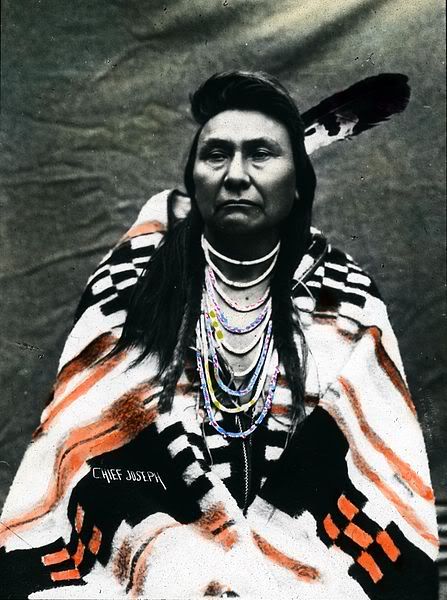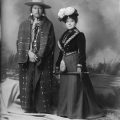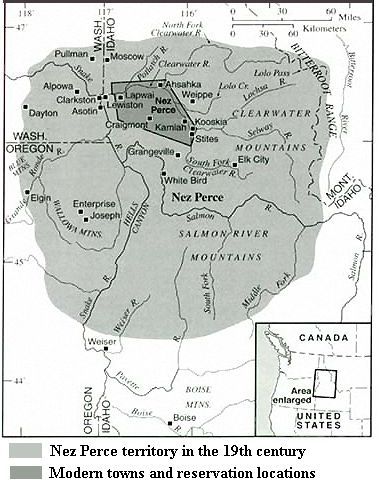
It is often said that the European invasion of the Americas was driven by three things: Gold, Glory, and God. Gold-fever often resulted in genocide or displacement of Indian nations. Concepts of law, of morality, of respect for others usually disappeared when gold was discovered on Indian land. One example of this can be seen on the Nez Perce land in Idaho in the 1860s.
The Nez Perce reservation in Idaho was created at the 1855 Walla Walla treaty council. The treaty with the Nez Perce clearly indicated that no American was to be allowed on the reservation without the consent of tribal leaders and the Indian agent.
In 1860, a group of ten American miners invaded the Nez Perce Reservation without the permission of the Indian agent or the Nez Perce chiefs. They made a rich gold discovery on Canal Gulch and then they claimed that the gold was found east of the Nez Perce Reservation, a claim they knew was false.
The following year, more than a thousand gold seekers invaded Nez Perce land in direct violation of the 1855 treaty. The superintendent of Indian affairs met with the Indian agent for the Nez Perce Reservation who recommended that the Nez Perce treaty be modified to allow the gold miners to stay. The Americans then met with Nez Perce chief Lawyer and his followers who agreed to sell the land around Pierce and Oro Fino. The area was opened to occupation in common with non-Indians and was for mining purposes only. The new treaty clearly indicated that the traditional root grounds and agricultural areas were to be for the exclusive use and benefit of the Indians.
In signing the new treaty, Nez Perce leader Lawyer reminded the Americans that the Nez Perce had not yet received any of the funds promised them in the 1855 treaty. The Americans promised to look into the matter and speed up payment.
The treaty was sent to Washington and was eventually ratified. Congress eventually appropriated only forty thousand dollars to pay for the land and there is no record that this money ever reached the Nez Perce. In the 1862 Senate debate regarding appropriations for the Nez Perce in Idaho, Senator J.W. Nesmith said:
“Treaties are written out conveying away millions of acres, not one word of which the Indians understand; and complicated articles involving the most abstruse legal provisions, furnishing subjects for interminable litigation, are fully explained and elucidated by some ignorant half-breed interpreter, who does not know one letter from another, but who acts under the direction of some politician, who desires to win his way to public favor by perpetrating a huge swindle upon those who have neither power or intelligence adequate to their own protection.”
Less than a month after the signing of the treaty, Lewiston, Idaho was founded in flagrant violation of the treaty. After some unsuccessful attempts to get the squatters to leave, Lawyer agreed to the building of a wharf and warehouse provided that no other permanent structures were built at the site. The Nez Perce had farms in the bottom area and wanted to retain this land. A few months later, however, the Americans laid out a permanent townsite.
Near the present-day town of Stites, Koolkool Snehee (Red Owl) encountered a group of miners and informed them that they were in violation of the treaty. After a long discussion, some of the prospectors returned to Oro Fino, but others snuck around the Indians and into the mountains. They later returned to announce their new gold strike and within a couple of months more than 2,000 miners had illegally invaded the area.
In 1861, the non-treaty Nez Perce under the leadership of Eagle-From-the-Light returned from visiting the Shoshone in the Weiser area and found that mining camps had been established in direct violation with earlier agreements. Eagle-From-the-Light quickly found that the American authorities refused to act in the matter, so he called a council in which he proposed an alliance with the Shoshone to drive the miners out. Red Owl and other Nez Perce leaders refused to go along with this idea. Eagle-From-the-Light gathered his people, vowed not to be a slave to the Americans like the other Nez Perce bands, and departed for Shoshone country in the south.
In 1862, the U.S. military held a grand council with the Nez Perce to propose stationing troops on the Clearwater River to protect the Indians from the lawless miners who were invading their territory. The Nez Perce chiefs attending the council included Lawyer, Joseph, and Big Thunder. As a result of the talks, a new military post, Fort Lapwai, was established near the village of Thunder Eyes. However, rather than being used to force the illegal squatters off Nez Perce land, the military tended to support the American squatters and create anxiety among the Nez Perce.
In 1862, an estimated $7-10 million in gold was taken from Nez Perce lands by non-Indian miners. It was estimated that there were about 15,000 miners on Nez Perce land in open defiance of their treaty. Some of the miners called upon the American government to move the Nez Perce to some other location.
With regard to the Nez Perce treaty, General Benjamin Alvord reported in 1862:
“Even now, at the end of seven years, I can find but few evidences of the fulfillment of the treaty. Lawyer has never received but six months of his salary as head chief, and the house with which he was to be provided has but just been commenced. Few of their annuities have ever reached them.”
In 1862, the Nez Perce received the first of the annuities promised them in the 1855 treaty. The payment was only $6,396 and Lawyer realized that he and his people were being cheated. He complained to the Americans, who simply ignored him.
With the passage of the Idaho Territorial Organic Act in 1863 Congress created Idaho Territory. With the creation of this new territory came increased pressure against the Nez Perce: the miners had their own politicians who could force federal actions against the Indians on behalf of the miners.
In 1863, the Americans met once again with the Nez Perce to negotiate a new treaty with them which would reduce their reservation. According to the American negotiators, this would “protect” the Nez Perce from illegal settlement. During the treaty council Nez Perce chief Lawyer talked to the Americans about breaking the treaty. He said:
“You have broken the treaty, not we. When you broke through the treaty, it did not make my heart sad or sore, I only wondered why you did it. Now, I am called on to look upon this proposition of yours after the Americans have broken the treaty so often.”
The American Indian agent addressed the council:
“We come as your friends, to advise with you, and to arrange for the preserving of your rights. As your friends we propose to you to relinquish to the United States a part of your present Reservation, and to take a new Reservation, smaller than the one you now hold. We also propose that on this new Reservation, each man or family shall have a piece of land in their own right [severalty], in their own name, just as the Americans do.”
He also said:
“We intend to act with perfect justice towards you, in the sight of God.”
In the treaty, the Nez Perce gave up nearly 7 million acres and retained only 785,000 acres for themselves. Fifty-one Nez Perce men signed the treaty. No leaders from outside the reservation area signed. None of these signing the treaty lost any land. One of the American participants in the council, Captain George B. Curry, reported:
“Although the treaty goes out to the world as the concurrent agreement of all the tribe, it is in reality nothing more than the agreement of Lawyer and his band, number in the aggregate not a third part of the Nez Perce tribe.”
The army commander at Fort Lapwai on the Nez Perce reservation was sent the following order:
“you are directed to protect-with a strong hand, and in the most-prompt-and vigorous manner, the Indians from all encroachments and aggressions.”
The army commander is also ordered to prevent the sale of liquor to the Indians.
In 1863, prior to the ratification of the treaty by the U.S. Senate, the lands ceded by the Nez Perce treaty were opened for American settlement.
Like many other Indian nations, the Nez Perce found that the discovery of gold on their lands was a curse rather than a blessing. Rather than benefitting from its riches, gold meant a loss of land and demonstrated to them to them the meaning of greed, a cultural value that was alien to Nez Perce traditions.
In 1881, the Secretary of the Interior wrote:
“There is nothing more dangerous to an Indian reservation than a rich mine.”




Leave a Reply